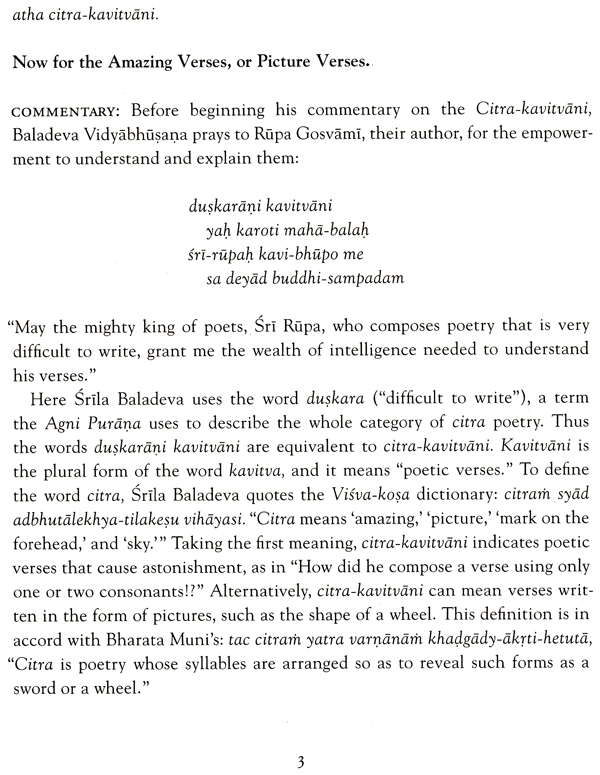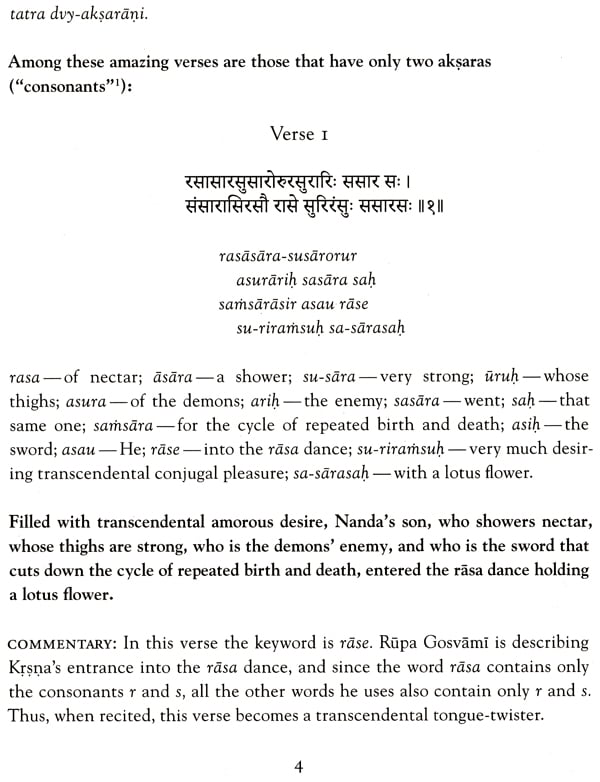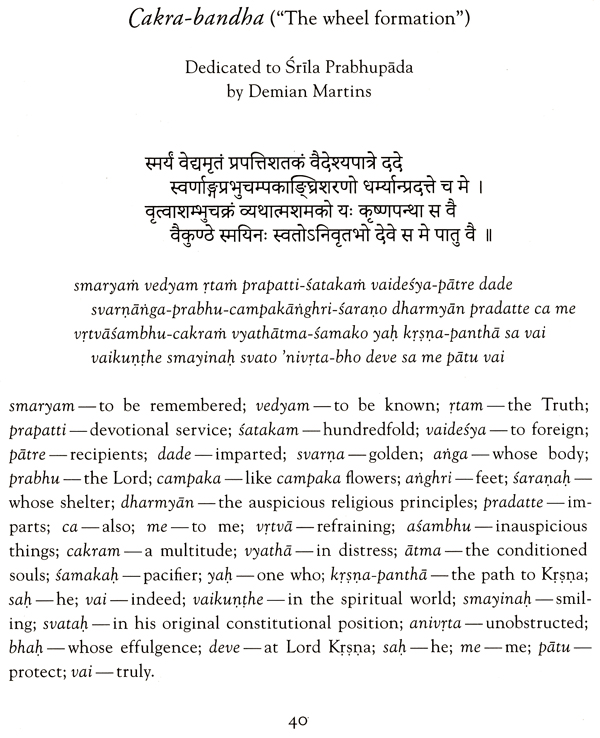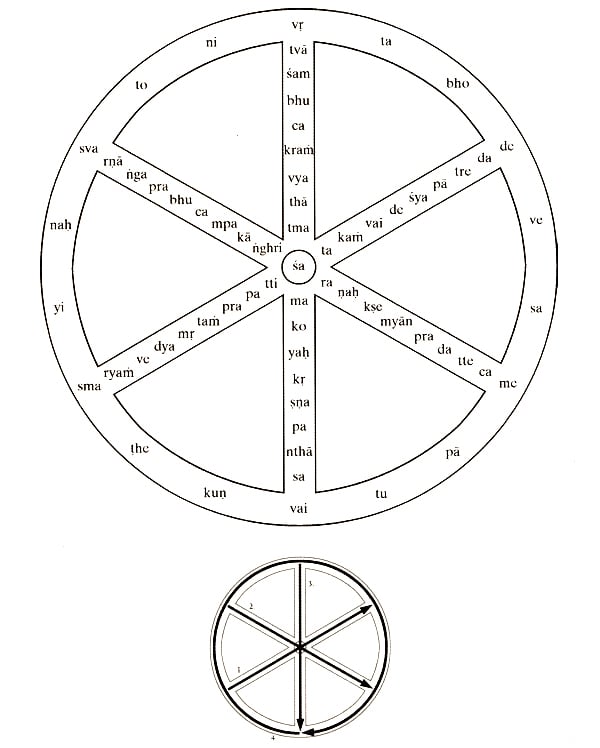
Citra Kavitvani of Srila Rupa Gosvami (With CD Inside)
Book Specification
| Item Code: | NAR956 |
| Author: | Matsya Avatara Dasa |
| Publisher: | Giriraja Publishing, Vrindavan |
| Language: | English |
| Edition: | 2014 |
| ISBN: | 9788192674315 |
| Pages: | 64 |
| Cover: | HARDCOVER |
| Other Details | 8.50 X 7.00 inch |
| Weight | 310 gm |
Book Description
The Citra-kavitvani is a collection of twelve amazing verses written by Srila RCipa Gosvami. These verses, full of transcendental tongue twisters and playful picture poetry, highlight Rupa Gosvami's genius as the fore-most poet among the Gaudiya Vaisnavas.
The book includes a CD with a video presentation of the Citra-kavitvani, a PowerPoint presentation, and an unabridged edition with a complete literal translation of Srila Baladeva Vidyabhusana’s commentary.
Srila Rupa Gosvami is well known among the Gaudiya Vaisnavas as the rasacarya (teacher of devotional feelings), having written extensively on the topic in his Bhakti-rasamrta-sindhu and Uilvala-nilarnani. Traditionally, rasa and its ingredients, the various bhavas (vibhavas, sattvika-bhavas, anubhavas, vyabhicari-bhavas, and sthayi-bhavas), comprise a subject matter that falls within the domain of kavya (poetry). Textbooks on kavya also typically cover other topics, such as figurative speech (laksanct), suggestion (vyanjana or dhvani), faults (dosas), and ornaments of sound and meaning (§abdalankaras and arthalankaras). Although Rupa Gosvami did not write a separate textbook on these other topics, his poems and dramas contain abundant examples of such ornaments and suggestions. In particular, his citra-kavitva verses, which are found in his Stava-mala, are brilliant examples of ornaments of sound (citra-kavitva verses as a genre are counted as §abdalankaras).
In a conversation with Sri Caitanya Mahaprabhu, Ramananda Raya said of Rupa Gosvami's writing: "Without Your mercy such poetic expressions would be impossible for an ordinary living being to write. My guess is that You have given him the power." (Caitanya-caritarnrta, Antya 1.196) He also said:
kith kavyena kaves tasya
kith kandena dhanus-matah
parasya hrdaye lagnath
na gharnayati yac chirah
"What is the use of a bowman's arrow or a poet's poetry if they penetrate the heart but do not cause the head to spin?" (Caitanya-caritamrta, Antya 1.195)
The twelve citra-kavitva verses presented in this book are guaranteed to spin the heads of sympathetic readers and leave them dumbstruck.
To facilitate this I recommend that the readers avail themselves of the ex-tra material on the cD accompanying this book, especially the Citra-kavitvani video presentation. This will provide an experience which transcends the confines of the written work. Also included on the CD is a PowerPoint presen-tation for those who wish to share this nectar with their communities while providing their own explanations. And for the serious scholars the cD includes an unabridged edition containing Devanagari diagrams and a complete literal translation of Srila Baladeva Vidyabhusana's commentary, with exhaustive footnotes.
I have taken the text from.four printed editions of the Stava-meila - those of Ramanarayana Vidyaratna, Puridasa, Aparna devi, and Tukaram Javaji (Ka vya-mala series, no. 84) - and have based my translations on Baladeva Vidyabhusana's commentary. Apart from a few obvious typographical errors, these editions hardly vary, but sometimes, when all the printed editions con-tained a false reading, I had to rescue the proper reading from old, handwrit-ten manuscripts, found at the Vrindavan Research Institute, and occasionally, when even those did not help, I had to deduce the proper reading by using re-verse engineering on the diagrams of the picture verses. All of this is explained in detail in the footnotes to the unabridged edition on the CD.
Among the Gaucliya Vaisnava authors, 8rila Kavi Karnapura also wrote many citra-kavitva verses in the seventh chapter of his Alankara-kaustubha (which will be published in its entirety by Giriraja Publishing), and a few in the third chapter of his Caitanya-caritamrta-mahakavya. And Srila Baladeva Vidyabhusana provided three original citra-kavitva verses and quoted some of Rupa Gosvami's, in his two textbooks on poetry, Kavya-kaustubha and Sahitya-kaumudi.
Srila Rupa Gosvami deserves to be honored as one of the greatest poets of all ages due to the monumental historical importance of his Sanskrit poems and dramas. In the Stava-mala, an extensive anthology of his poems compiled by Srila Jiva Gosvami, we can appreciate in every line the vastness of his wisdom, the subtlety of his language, the sweetness of his mood, and, above all, the depth of his unalloyed devotion to his beloved Lordships, Sri Sri Radha and Krsna. Among the poems included in the Stava-mala we find a collection of twelve verses in the citra-kavitva genre, in which the author displays his poetic dexterity in an astounding way. Lord Caitanya's philosophy emphasizes variety in oneness, and thus it is appropriate to say that although Srila Rupa Gosvami's poems are all exquisite and dazzling, the citra-kavitva verses are particularly impressive and charming. In fact, due to their amusing constructions, they can attract even people otherwise uninterested in poetry.
Sanskrit is by nature a highly poetic language. This is shown by the perfect metrical patterns of the eternal Vedas. Also, the vast majority of revealed scriptures and human compositions consist of innumerable forms of verse (even in books on such topics as medicine or civil law). Srila Vyasadeva and Adi-kavi Valmiki gave preference to the anustup meter, a thirty-two syllable verse form, while later poets explored many other varieties of meters, comprising from one to several dozen syllables per quarter. Versification became even more elaborate when, besides syllables, the poets started to divide the quarters according to moraes, units based on the length of the phonemes. The figures of expression (alankaras) and the genres of composition developed considerably from century to century, and at some point poetry became a very sophisticated art accessible only to highly educated brcihmartas and royalty. Writing it became a challenge for new authors, and understanding it became a challenge for the readers. Some exceptional works are the Rama-krma-vdoma-kavyam of Daivajfia Suryakavi ( i4th century AD), which narrates the pastimes of Lord Rama when read forward and those of Lord Krsna when read backward; Reighava-yadava-pandaviyam of Cidambara (I6th century AD), in which the same verses can be interpreted three diffferent ways to describe incidents from the Ramayarta, grimad-Bhagavatam, and Mahabharata; Raghava-pandaviyam of Venkatadhvari ( i7th century AD), which narrates pastimes from the Ramayanct when read forward and those of the Mahabharata when read backward. Among the most diffi-cult kinds of compositions are the various forms of citra-kavitva, which have been in vogue for at least two thousand years. Great poets like Bharavi (c. 6th century AD), Magha (c. 7th century AD), and 8riharsa (1 zth century AD) wrote citra-kavitva. Among Vaisnava poets, the works of Vedanta-degika ( i4th century AD) are perhaps the most astonishing. Answering a challenge, he composed the Paduka-sahasram, ioo8 verses praising the sandals of Lord Ranganatha, in a single night. The collection contains forty breathtaking citra-kavitva verses.
In composing his citra-kavitva 8rila Rupa Gosvami had the benefit of hun-dreds of years of tradition established by a multitude of renowned poets, yet he far surpassed many of them by diverging from the usual mundane love theme and depicting instead the loving pastimes of Lord Krsna and His dearmost dev-otees. Such poetic descriptions emanating from the heart of a maha-bhagavata give great pleasure to the Lord and His devotees, and therefore they deserve to be venerated and recited alongside the Vedas and Puranas. Yet if one wishes to deeply relish the innumerable rasas flowing in these poems, a good command of Sanskrit is an unavoidable prerequisite.
In the introduction to his Pada-kaustubha, 8rila Baladeva Vidyabhusana compares the Sanskrit grammar to a vast ocean of nectar: only one who dives in it will be able to know the flavors hidden there. It is remarkable that in the beginning of his commentary to Srila Rupa Gosvami's citra-kavitva verses, 8rila Vidyabhusana prays to the Lord for the ability to understand such exceedingly difficult poetry. If he had not clarified some of the poems, it would have been much more difficult for later generations of Vaispavas to grasp their intended meaning. Nevertheless, given the complexity and character of the genre, we should keep in mind that his commentary is not meant to be exhaustive, and that other scholars may eventually present other valid interpretations of these very same verses and highlight other poetic features as well. To bring solace to those who cannot read the original, Matsya Avatara Dasa presents a brilliant translation in elegant vernacular for both the verses and the Sanskrit commentary. This edition elucidates the intricacies of the versification and the meaning of every word and thus makes these amazing gems taken from the nectarean ocean of Srila Rupa Gosvami's poetry easily accessible.
**Contents and Sample Pages**










